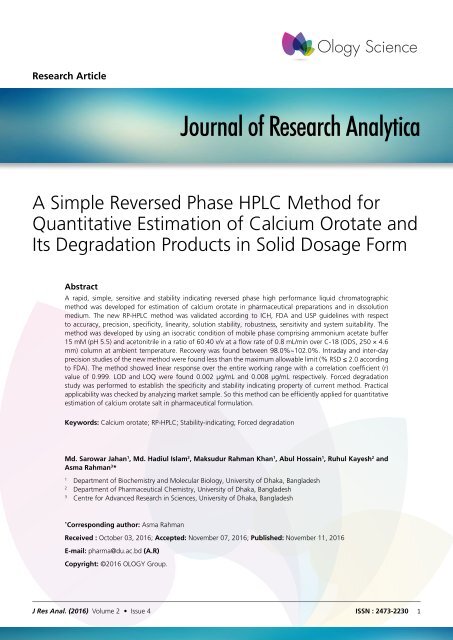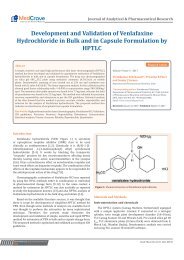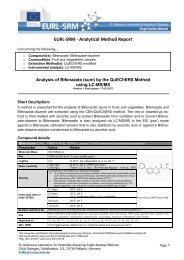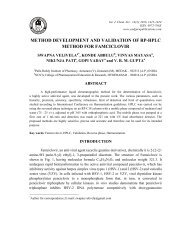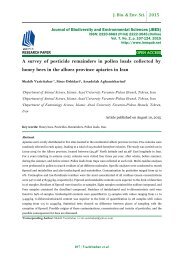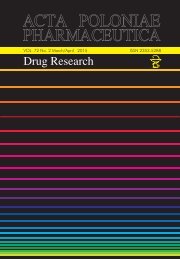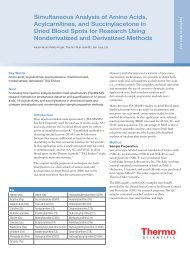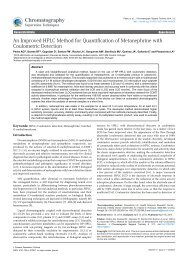Journal of Research Analytica
A-Simple-Reversed-Phase-HPLC-Method-for-Quantitative-Estimation-of-Calcium-Orotate-and-Its-Degradation-Products-in-Solid-Dosage-Form
A-Simple-Reversed-Phase-HPLC-Method-for-Quantitative-Estimation-of-Calcium-Orotate-and-Its-Degradation-Products-in-Solid-Dosage-Form
Create successful ePaper yourself
Turn your PDF publications into a flip-book with our unique Google optimized e-Paper software.
Ology Science<br />
<strong>Research</strong> Article<br />
<strong>Journal</strong> <strong>of</strong> <strong>Research</strong> <strong>Analytica</strong><br />
A Simple Reversed Phase HPLC Method for<br />
Quantitative Estimation <strong>of</strong> Calcium Orotate and<br />
Its Degradation Products in Solid Dosage Form<br />
Abstract<br />
A rapid, simple, sensitive and stability indicating reversed phase high performance liquid chromatographic<br />
method was developed for estimation <strong>of</strong> calcium orotate in pharmaceutical preparations and in dissolution<br />
medium. The new RP-HPLC method was validated according to ICH, FDA and USP guidelines with respect<br />
to accuracy, precision, specificity, linearity, solution stability, robustness, sensitivity and system suitability. The<br />
method was developed by using an isocratic condition <strong>of</strong> mobile phase comprising ammonium acetate buffer<br />
15 mM (pH 5.5) and acetonitrile in a ratio <strong>of</strong> 60:40 v/v at a flow rate <strong>of</strong> 0.8 mL/min over C-18 (ODS, 250 × 4.6<br />
mm) column at ambient temperature. Recovery was found between 98.0%~102.0%. Intraday and inter-day<br />
precision studies <strong>of</strong> the new method were found less than the maximum allowable limit (% RSD ≤ 2.0 according<br />
to FDA). The method showed linear response over the entire working range with a correlation coefficient (r)<br />
value <strong>of</strong> 0.999. LOD and LOQ were found 0.002 µg/mL and 0.008 µg/mL respectively. Forced degradation<br />
study was performed to establish the specificity and stability indicating property <strong>of</strong> current method. Practical<br />
applicability was checked by analyzing market sample. So this method can be efficiently applied for quantitative<br />
estimation <strong>of</strong> calcium orotate salt in pharmaceutical formulation.<br />
Keywords: Calcium orotate; RP-HPLC; Stability-indicating; Forced degradation<br />
Md. Sarowar Jahan 1 , Md. Hadiul Islam 2 , Maksudur Rahman Khan 1 , Abul Hossain 1 , Ruhul Kayesh 2 and<br />
Asma Rahman 3 *<br />
1<br />
Department <strong>of</strong> Biochemistry and Molecular Biology, University <strong>of</strong> Dhaka, Bangladesh<br />
2<br />
Department <strong>of</strong> Pharmaceutical Chemistry, University <strong>of</strong> Dhaka, Bangladesh<br />
3<br />
Centre for Advanced <strong>Research</strong> in Sciences, University <strong>of</strong> Dhaka, Bangladesh<br />
*<br />
Corresponding author: Asma Rahman<br />
Received : October 03, 2016; Accepted: November 07, 2016; Published: November 11, 2016<br />
E-mail: pharma@du.ac.bd (A.R)<br />
Copyright: ©2016 OLOGY Group.<br />
J Res Anal. (2016) Volume 2 • Issue 4 ISSN : 2473-2230<br />
1
Citation: Jahan SM, Islam HM, Khan MR, Hossain A, Kayesh R, Asma Rahman. A simple reversed phase HPLC method for quantitative estimation <strong>of</strong><br />
calcium orotate and its degradation products in solid dosage form. J Res Anal. 2016; 2(4): 108-112.<br />
Introduction<br />
Calcium orotate is the calcium salt <strong>of</strong> orotic acid (Figure 1).<br />
Chemically, orotic acid is 1,2,3,6-tetrahydro-2,6-dioxo-4-<br />
pyrimidinecarboxylic acid. It is white to almost white crystalline<br />
powder with poor water solubility [1].This salt is mainly given as<br />
calcium supplement in people who do not get enough calcium<br />
from daily food intake [2,3]. It is also used as medication to<br />
treat conditions caused by low calcium levels such as bone loss<br />
(osteoporosis), weak bones (osteomalacia/rickets), decreased<br />
activity <strong>of</strong> the parathyroid gland (hypoparathyroidism), and a<br />
certain muscle disease (latent tetany) [3,4]. It may also be used in<br />
certain patients to make sure they are getting enough calcium, e.g.,<br />
women who are pregnant, nursing, or postmenopausal, people<br />
taking certain medications such as phenytoin, phenobarbital, or<br />
prednisone [3].<br />
As a source <strong>of</strong> calcium supplement calcium supplement it is<br />
far superior to all other conventional calcium salts now being used<br />
[5]. For example, calcium orotate is absolutely free <strong>of</strong> any side<br />
effects. Conventional calcium salts have certain problems when<br />
applied in osteoporosis with concomitant arteriosclerosis <strong>of</strong> the<br />
abdominal aorta. Calcium orotate, on the other hand, protects<br />
the body from arteriosclerosis. Calcium orotate can penetrate the<br />
complex cell membranes and therefore, it can compensate for a<br />
disturbed calcium transport through these cell membranes. In<br />
addition, calcium orotate has a special affinity for bradytrophic<br />
tissue (e.g. Cartilage) where it is metabolized [6]. Parallel studies<br />
have shown that a defective calcium transport through the<br />
cell membrane is <strong>of</strong> great pathogenetical significance. So, this<br />
substance is a very satisfactory agent in the re-calcification <strong>of</strong><br />
metastatic defects in the skeletal system and in other calcium<br />
deficiency syndrome [4].<br />
Calcium orotate can be assayed by complexometric titration,<br />
polarographic method, UV or chromatographic method [1]. An<br />
UV method has been stated for estimation <strong>of</strong> calcium orotate<br />
in bulk and in tablets [7]. To the best <strong>of</strong> our knowledge,<br />
there is no HPLC analytical method for its estimation in bulk<br />
or in pharmaceutical formulations. Here, we developed a<br />
rapid, sensitive and stability indicating RP-HPLC method for<br />
quantification <strong>of</strong> calcium orotate and this was validated following<br />
the <strong>of</strong> FDA, USP and ICH guidelines.<br />
Materials and methods<br />
Working standard <strong>of</strong> calcium orotate (98.5% potency) was<br />
a kind gift <strong>of</strong> ACI Pharmaceuticals Ltd., Bangladesh. HPLC<br />
grade acetonitrile and methanol were obtained from Active Fine<br />
Chemicals Ltd., Bangladesh. For the estimation <strong>of</strong> calcium orotate<br />
formulated as tablets, samples produced by three renowned<br />
pharmaceutical industries in Bangladesh were collected from the<br />
market. These samples were coded as S1, S2 and S3.<br />
O<br />
HN<br />
O<br />
N<br />
H<br />
O<br />
O<br />
Ca<br />
N<br />
H<br />
NH<br />
Figure 1: Chemical structure <strong>of</strong> calcium Orotate.<br />
O<br />
O<br />
O<br />
O<br />
HPLC system<br />
High Performance Liquid Chromatographic system<br />
(Shimadzu-UFLC Prominence, Japan), equipped with an auto<br />
sampler (Model- SIL 20AC HT) and UV-Visible detector<br />
(Model-SPD 20A) was used for the analysis. The data was<br />
recorded using LCsolutions s<strong>of</strong>tware. <strong>Analytica</strong>l reversed phase<br />
C-18 column [ProntoSIL C18, 4.6 x 250 mm, India.] was used<br />
to analyze the standards and samples.<br />
Preparation <strong>of</strong> mobile phase: 1.15 g <strong>of</strong> ammonium acetate<br />
was dissolved in 900 mL <strong>of</strong> HPLC grade water. The pH was<br />
adjusted to 5.5 ± 0.1 with dilute acetic acid or ammonia solution<br />
and then volume was made up to 1000 mL with water <strong>of</strong> same<br />
quality. Then this buffer and HPLC grade acetonitrile were mixed<br />
together at a ratio <strong>of</strong> 60:40 v/v. Finally it was filtered through a<br />
0.22 µm millipore filter and sonicated.<br />
Preparation <strong>of</strong> standard solutions: 25 mg <strong>of</strong> calcium<br />
orotate was taken in 100 mL distilled water and sonicated for<br />
10 minutes to dissolve completely. Thus stock solution <strong>of</strong> 250<br />
µg/mL was found. 5 mL <strong>of</strong> this solution was taken into another<br />
50 mL volumetric flask and diluted with distilled water to get<br />
nominal concentration <strong>of</strong> 25 µg/mL. The stock solution was<br />
further diluted with distilled water.<br />
Sample preparation: Twenty tablets <strong>of</strong> each sample were<br />
grinded to make powder and then powdered tablet equivalent<br />
to 50 mg <strong>of</strong> calcium orotate was dissolved in 100 mL distilled<br />
water by proper sonication. Then 5 mL <strong>of</strong> this solution was taken<br />
in another 100 mL volumetric flask and volume was adjusted by<br />
distilled water.<br />
Chromatographic condition: An isocratic mobile phase was<br />
consisted <strong>of</strong> acetate buffer and acetonitrile at a ratio <strong>of</strong> 60:40.<br />
Flow rate <strong>of</strong> mobile phase was 0.8 mL/min through C18 column<br />
for 5 minutes. The injection volume was 20 µL. Before analysis,<br />
all standard and sample solutions were filtered through 0.2 µm<br />
filter tips. The column eluent was monitored with UV detection<br />
at 275 nm.<br />
Parameters <strong>of</strong> method validation<br />
Specificity: The specificity <strong>of</strong> the LC method was evaluated<br />
to ensure that there was no interference from the degradation<br />
products, excipients or other impurities in the pharmaceutical<br />
formulation [8-10].<br />
Solution stability: The solution stability <strong>of</strong> standards and<br />
samples was established under normal bench top conditions,<br />
normal storage conditions, and sometimes in the instrument<br />
to determine where special storage conditions are necessary<br />
or not, for instance, refrigeration or protection from light.<br />
For this method, stability <strong>of</strong> standard solution was studied by<br />
keeping a single concentration by diluting standard solution in<br />
tightly capped volumetric flask at room temperature (25°C) on<br />
laboratory bench and at 5°C in refrigerator for 72 hours. The<br />
solutions were analyzed by HPLC at 0 hr, 24 hr, 48 hr and 72 hr.<br />
Forced degradation: In this stage, forced degradation studies<br />
were undertaken to degrade the sample (e.g., drug product<br />
or API) deliberately. These studies were used to evaluate an<br />
analytical method’s ability to measure an active ingredient and<br />
its degradation products without interference. Samples <strong>of</strong> drug<br />
2 ISSN : 2473-2230<br />
J Res Anal. (2016) Volume 2 • Issue 4<br />
Ology Science
Citation: Jahan SM, Islam HM, Khan MR, Hossain A, Kayesh R, Asma Rahman. A simple reversed phase HPLC method for quantitative estimation <strong>of</strong><br />
calcium orotate and its degradation products in solid dosage form. J Res Anal. 2016; 2(4): 108-112.<br />
product (spiked placebo) and drug substance were exposed to<br />
acid (0.1N~1.0N HCl), base (0.1N~1N NaOH), oxidizing<br />
agent (10% ~30% H 2<br />
O 2<br />
solution )<br />
, reducing agent (10% ~30%<br />
Na bisulphate solution) and water for 24 hours to produce at<br />
least 10% degradation. The degraded samples were then analyzed<br />
using the method to determine if there are interferences with the<br />
active or related compound(s).<br />
Linearity and range: Five different concentration levels <strong>of</strong><br />
calcium orotate (20 µg/mL, 22 5µg/mL, 25 µg/mL, 27.5 µg/mL,<br />
and 30 µg/mL) were prepared from stock solution. The average<br />
peak areas were plotted against concentrations. The linearity <strong>of</strong><br />
the proposed method was evaluated by using calibration curve.<br />
Accuracy: The accuracy <strong>of</strong> an analytical method expresses<br />
the nearness between the expected value and the value found.<br />
In present study, successive analysis (n=3) for three different<br />
concentrations (20 µg/mL, 25 µg/mL, 30 µg/mL) <strong>of</strong> standard<br />
solution <strong>of</strong> active drug were carried out to determined the<br />
accuracy <strong>of</strong> proposed method.<br />
Precision: The precision <strong>of</strong> the proposed method was<br />
checked by intra- and inter-day repeatability <strong>of</strong> responses after<br />
replicate injections and expressed as %RSD amongst responses<br />
using the following formula<br />
% RSD = (Standard deviation/Mean) x 100%<br />
Robustness: Robustness measures the capacity <strong>of</strong> an<br />
analytical method to remain unaffected by small but deliberate<br />
variations in the parameters <strong>of</strong> the method. Robustness provides<br />
some indication <strong>of</strong> reliability <strong>of</strong> the analytical method during<br />
normal usage.<br />
System suitability: System suitability is commonly used<br />
ensure a method’s adequacy for a particular analysis. The following<br />
parameters are verified in system suitability tests: number <strong>of</strong><br />
theoretical plate, tailing factor, resolution and repeatability at<br />
100% test concentration.<br />
Limit <strong>of</strong> detection (LOD) and limit <strong>of</strong> quantification<br />
(LOQ)<br />
LOD is the lowest amount <strong>of</strong> analyte in a sample that can<br />
be detected but not necessarily quantified under the stated<br />
experimental conditions. On the other hand LOQ is the lowest<br />
amount <strong>of</strong> analyte in a sample that may be determined with<br />
acceptable accuracy and precision.<br />
Results and Discussion<br />
HPLC method development<br />
Calcium orotate is slightly soluble in water and practically<br />
insoluble in methanol and ethanol [1]. It is also slightly soluble<br />
in acetonitrile. The pKa value <strong>of</strong> orotic acid is 2.83 [11,12] which<br />
suggests a pH <strong>of</strong> buffer solution should be 4.83 or above. So<br />
we tried different ratio <strong>of</strong> ammonium acetate buffered solution<br />
and acetonitrile to find optimum condition. Finally, 10 mM<br />
buffer (pH 5.5) solution and acetonitrile in a ratio <strong>of</strong> 60:40<br />
v/v produced well shaped and sharp chromatographic peak <strong>of</strong><br />
calcium orotate at 2.9 minute. The method was summarized in<br />
Table 1. Typical chromatogram <strong>of</strong> standard clcium orotate was<br />
shown in Figure 2.<br />
Validation result<br />
Specificity: The specificity <strong>of</strong> the LC method was evaluated<br />
to ensure that there was no interference from the degradation<br />
products, excipients, or other impurities in the region <strong>of</strong> actives.<br />
The specificity was studied by injecting the unstressed and<br />
stressed standard solutions, samples, and blanks.<br />
Solution stability: Two vials <strong>of</strong> standard solution were<br />
kept for solution stability study. One vial was kept in ambient<br />
condition and another in refrigerator. AUC (area under curve)<br />
changes were recorded by this developed method using the same<br />
machine and column. Day to day area changes were observed<br />
with respect to initial area (0 th hour). Low % RSD indicates<br />
no major variation among the AUC recorded on different day,<br />
which inturn is an indicator <strong>of</strong> solution stability <strong>of</strong> calcium<br />
orotate. Results were shown in Table 2.<br />
Forced degradation: Stressed samples were analyzed<br />
against freshly prepared standard. Degradation was measured in<br />
terms <strong>of</strong> AUC change between the stressed sample and freshly<br />
prepared standard. The drug found fairly stable in acidic, basic<br />
and aqueous environment, but it was degraded significantly by<br />
oxidation and reduction. This study substantiates the use <strong>of</strong><br />
water as diluting solution. These data can be proved useful in<br />
formulation development <strong>of</strong> this drug. Results were summarized<br />
in Table 3.The chromatograms <strong>of</strong> degradation products were<br />
shown in Figure 3.<br />
Linearity, range and accuracy: Linearity <strong>of</strong> calcium orotate<br />
was examined over 50% ~ 200% <strong>of</strong> nominal concentration<br />
(i.e. 12.5 µg/mL to 50 µg/mL). Linearity curve was created by<br />
plotting AUC <strong>of</strong> chromatograms against the corresponding<br />
concentration. The method showed good linear response <strong>of</strong><br />
concentration with correlation coefficient (r) value <strong>of</strong> 0.999.<br />
Linear equation was found as below:<br />
y=67622x + 27665; y=AUC <strong>of</strong> chromatographic peak,<br />
x=Concentration<br />
This method followed Beer- Lambert law over a wide range<br />
<strong>of</strong> concentration between 12.5 µg/mL to 50 µg/mL. Accuracy <strong>of</strong><br />
this method was calculated from the percent recovery <strong>of</strong> known<br />
concentration calculated by linear equation. The % recoveries<br />
were found above 99% and % RSD among the recoveries was<br />
found very low which indicated accuracy <strong>of</strong> this method. Results<br />
were shown in Table 4.<br />
Precision: Precision (both intraday and inter-day) was<br />
checked in terms <strong>of</strong> %RSD <strong>of</strong> recovered concentrations. The<br />
%RSD values depicted in Table 5 showed that the proposed<br />
method provides acceptable intra-day and inter-day variation <strong>of</strong><br />
the reproducibility <strong>of</strong> current method.<br />
System suitability: All the system suitability parameters met<br />
the acceptance value. Table 6 summarized the results.<br />
Table 1: HPLC chromatographic conditions in developed method.<br />
HPLC Method<br />
Column<br />
Flow rate<br />
Monitoring wave length<br />
Tempearture<br />
Retention time<br />
15mM Ammonium Acetate Buffer (pH 5.5) :<br />
Acetonitrile = 60:40 (%v/v)<br />
C18, 5µm , 250 x 4.6 mm<br />
0.8 ml/min<br />
275 ƞm<br />
Ambient<br />
2.90±0.1 minute<br />
Ology Science J Res Anal. (2016) Volume 2 • Issue 4 ISSN : 2473-2230<br />
3
2.90/ Calcium Orotate<br />
Citation: Jahan SM, Islam HM, Khan MR, Hossain A, Kayesh R, Asma Rahman. A simple reversed phase HPLC method for quantitative estimation <strong>of</strong><br />
calcium orotate and its degradation products in solid dosage form. J Res Anal. 2016; 2(4): 108-112.<br />
uV<br />
150000<br />
Detector A - Ch1<br />
100000<br />
50000<br />
0<br />
0.0 0.5 1.0 1.5 2.0 2.5 3.0 3.5 4.0 4.5 5.0<br />
min<br />
Table 2: Solution stability <strong>of</strong> calcium orotate with respect to AUC changes.<br />
Figure 2: Chromatogram <strong>of</strong> Calcium Orotate.<br />
Testing Time (hour) AUC <strong>of</strong> ambient sample (n=3) AUC <strong>of</strong> refrigerator sample (n=3)<br />
0 th 1754900 1754900<br />
24 th 1725575 1728495<br />
48 th 1721739 1725106<br />
72 th 1719795 1718489<br />
% RSD 0.950 0.923<br />
Table 3: Result <strong>of</strong> forced degradation study.<br />
AUC <strong>of</strong> standard solution Type <strong>of</strong> Degradation AUC <strong>of</strong> degraded sample (n=3) % Loss Remark<br />
1095920<br />
(n=6)<br />
Acid Hydrolysis 1083416 1.1 % Less sensitive<br />
Basic hydrolysis 1067725 2.5% Less sensitive<br />
Water hydrolysis 1072920 2.0% Less sensitive<br />
Oxidation 356503 67% Highly sensitive<br />
Reduction 673860 38% Highly sensitive<br />
uV<br />
5000<br />
2500<br />
3.10 / Calcium Orotate<br />
3.73 / Degradant -A<br />
4.63 / Degradant -B<br />
uV<br />
100000<br />
50000<br />
Calcium Orotate / 3.1<br />
uV<br />
750<br />
500<br />
250<br />
1 Det<br />
0<br />
0.0 2.5 5.0 7.5 10.0<br />
min<br />
0<br />
a<br />
Summary (Compound)<br />
Red 1. lcD<br />
Calcium Orotate / 3.0<br />
Unknown Degradant -B / 4.4<br />
0.0 2.5 5.0 7.5 10.0<br />
min<br />
c<br />
Unknown Degradant - C / 6.1<br />
1 Det A<br />
uV<br />
0<br />
50000<br />
25000<br />
0 5 10<br />
min<br />
0<br />
b<br />
Summary (Compound)<br />
Ox 1.lcd<br />
Calcium Orotate / 2.9<br />
2 3 4 5<br />
min<br />
Figure 3: Chromatograms <strong>of</strong> forced degradation: (a) Acid hydrolysis, (b) Basic hydrolysis, (c) Reduction, (d) Oxidation.<br />
d<br />
Oxidized Product / 3.6<br />
1 Det A Ch1<br />
1 Det A Ch1<br />
4 ISSN : 2473-2230<br />
J Res Anal. (2016) Volume 2 • Issue 4<br />
Ology Science
Citation: Jahan SM, Islam HM, Khan MR, Hossain A, Kayesh R, Asma Rahman. A simple reversed phase HPLC method for quantitative estimation <strong>of</strong><br />
calcium orotate and its degradation products in solid dosage form. J Res Anal. 2016; 2(4): 108-112.<br />
Robustness: This method also showed acceptable changes<br />
in robustness study and established its stability and reliability<br />
thereby. Result was shown in Table 7.<br />
Market product analysis: To evaluate the practical<br />
applicability <strong>of</strong> the developed method, three different brands<br />
<strong>of</strong> calcium orotate formulated as tablets by three renowned<br />
pharmaceutical industries in Bangladesh were collected to<br />
determine the assay and dissolution by this method. All<br />
three brands claim 400 mg calcium orotate per tablet in their<br />
formulation. Results were presented in Table 8.<br />
Table 4: Result <strong>of</strong> linearity, range and accuracy.<br />
Injected Conc.<br />
(µg/mL)<br />
% <strong>of</strong><br />
nominal<br />
Average AUC<br />
(n=6)<br />
Recovered<br />
Concentration<br />
%<br />
Recovery<br />
12.5 50% 862820 12.35 98.8<br />
20 80% 1378895 19.9 99.9<br />
22.5 90% 1542656 22.4 99.5<br />
25 100% 1721739 25.05 100.2<br />
27.5 110% 1896123 27.63 100.5<br />
30 120% 2071599 30.22 100.7<br />
50 200% 3398864 49.85 99.7<br />
% RSD <strong>of</strong> recoveries 0.646%<br />
Table 5: Result <strong>of</strong> intraday and inter-day precision.<br />
Run Order<br />
% RSD intraday <strong>of</strong><br />
variation (n=6)<br />
Day-1,Analyst-1 0.2433<br />
Day-2,Analyst-2 0.5802<br />
Day-3,Analyst-3 1.1214<br />
Table 6: System suitability parameters.<br />
% RSD <strong>of</strong> inter-day<br />
variation<br />
0.2490<br />
Parameter Average (n=6) % RSD<br />
Acceptance<br />
Limit [8-10]<br />
Peak Area 1721739 0.276 %RSD


